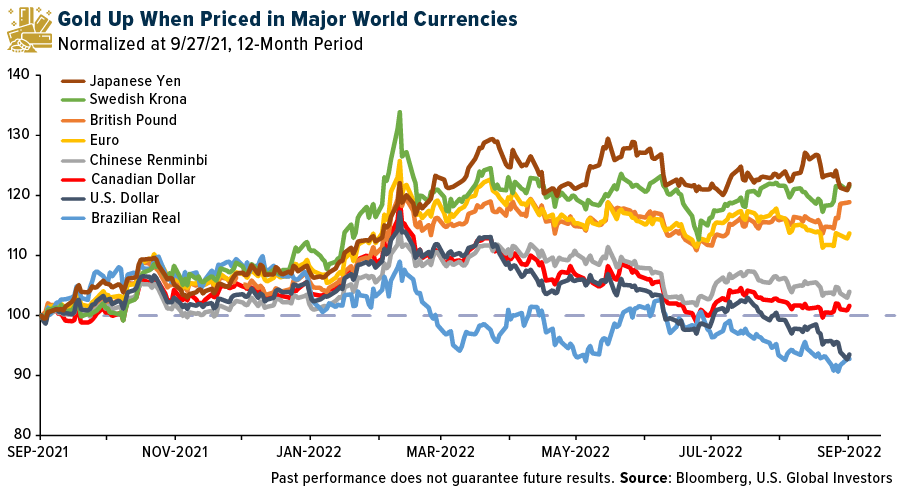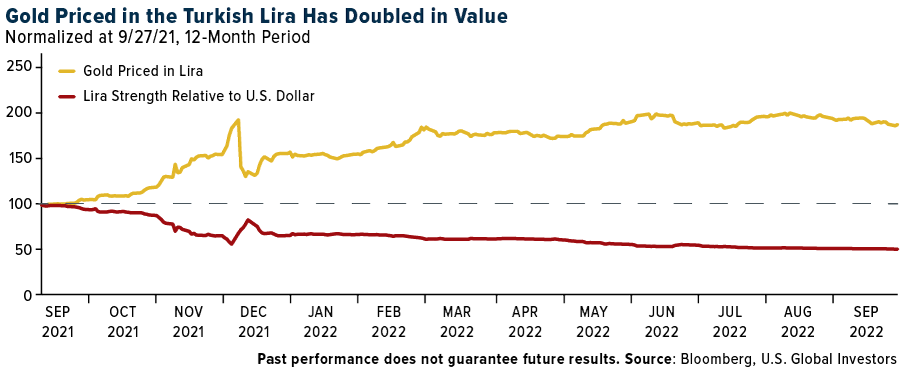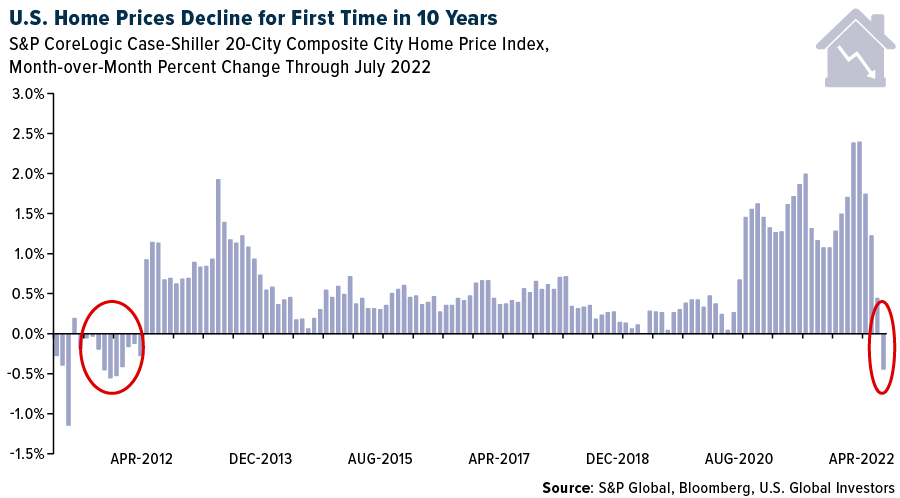“Gold is no longer a safe haven.” “Gold isn’t an effective hedge against inflation.” “Gold is dead.”
You may have heard and read these comments, and others like it, numerous times over the course of the recent “everything selloff.” This is staggeringly shortsighted to us. Gold is down only around 9.5% for the year as of September 27, despite surging bond yields, and despite the U.S. dollar being at its strongest level ever relative to other major currencies.
Given these headwinds, you would expect gold to have lost far more of its value than it has. But compared to other assets, from stocks to bonds to digital currencies, the yellow metal has been remarkably resilient.
And that’s gold priced in the U.S. dollar. When we price it in other world currencies, gold has done even better since many currencies have declined significantly in value relative to the greenback. The British pound sterling has fallen to an all-time low against the dollar, as has the Chinese renminbi.
Of the various gold prices shown below, only two—those priced in the dollar and Brazilian real—were negative for the year as of September 27. The others, including gold priced in the Canadian dollar, were positive.

Many Turks Favor Gold, According to Survey
Perhaps 2022’s best gold performance has occurred in Turkey, where the lira has fallen some 52% on jaw-dropping annual inflation of 80%. Gold has doubled in price since the start of the year, helping foresighted investors protect their wealth against runaway consumer prices. Turks have traditionally invested in the precious metal, and many still prefer it as a store of value, according to a May survey by Areda Survey. Nearly 43% of those surveyed said they consider gold to be an attractive investment.

Recession Signs Intensify with Falling Home Prices
There are a number of signs that the global economy could be headed for a recession (or that we’re already in one), the most recent of which is that U.S. home prices are in freefall. The Case-Shiller 20-City Index posted its first month-over-month decline in 10 years. Although released in September, the data records prices as of the end of July, meaning home prices may have slipped even further since then.

To be clear, we don’t believe this depreciation will be as severe as it was during the 2007-2008 housing crisis. Banks are not nearly as speculative as they were then, meaning they’re generally not lending to borrowers with poor credit quality. The delinquency rate on single-family mortgages is currently below 2%, which we haven’t seen since 2006, just before the crisis.
Nevertheless, rates are ticking up, which could prompt unemployment to spike. Many American homeowners could therefore end up defaulting on their home loans.
If it all comes crashing down, we would want to have some gold in our portfolio, which has historically been an attractive store of value when markets cratered.
Explore investment opportunities by considering our U.S. Global GO GOLD and Precious Metal Miners ETF (GOAU).
All opinions expressed and data provided are subject to change without notice. Some of these opinions may not be appropriate to every investor.
Please carefully consider a fund’s investment objectives, risks, charges, and expenses. For this and other important information, obtain a statutory and summary prospectus for GOAU here. Read it carefully before investing.
Investing involves risk, including the possible loss of principal. Shares of any ETF are bought and sold at market price (not NAV), may trade at a discount or premium to NAV and are not individually redeemed from the funds. Brokerage commissions will reduce returns.
Because the funds concentrate their investments in specific industries, the funds may be subject to greater risks and fluctuations than a portfolio representing a broader range of industries. The funds are non-diversified, meaning they may concentrate more of their assets in a smaller number of issuers than diversified funds.
The funds invest in foreign securities which involve greater volatility and political, economic and currency risks and differences in accounting methods. These risks are greater for investments in emerging markets. The funds may invest in the securities of smaller-capitalization companies, which may be more volatile than funds that invest in larger, more established companies.
The performance of the funds may diverge from that of the index. Because the funds may employ a representative sampling strategy and may also invest in securities that are not included in the index, the funds may experience tracking error to a greater extent than funds that seek to replicate an index.
The funds are not actively managed and may be affected by a general decline in market segments related to the index. Gold, precious metals, and precious minerals funds may be susceptible to adverse economic, political, or regulatory developments due to concentrating in a single theme. The prices of gold, precious metals, and precious minerals are subject to substantial price fluctuations over short periods of time and may be affected by unpredicted international monetary and political policies. We suggest investing no more than 5% to 10% of your portfolio in these sectors.
Fund holdings and allocations are subject to change at any time. Click to view fund holdings for GOAU.
Distributed by Quasar Distributors, LLC. U.S. Global Investors is the investment adviser to GOAU. The S&P CoreLogic Case-Shiller 20-City Composite Home Price Index seeks to measures the value of residential real estate in 20 major U.S. metropolitan areas: Atlanta, Boston, Charlotte, Chicago, Cleveland, Dallas, Denver, Detroit, Las Vegas, Los Angeles, Miami, Minneapolis, New York, Phoenix, Portland, San Diego, San Francisco, Seattle, Tampa and Washington,
